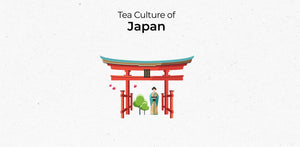Japan
History
Ancient scripts tell us that Japan was first introduced to tea in the 7th century. During this time, large envoys of Buddhist monks were sent to China to learn about its rich culture. At times, these envoys were accompanied by Japanese scholars. Saicho, Kukai and Eichu, were the first Japanese to be introduced to tea. Bringing back seeds of tea, Saicho introduced Japan to China’s popular beverage. Emperor Saga loved this royal beverage for its vegetal aroma and briskness. He encouraged the growth of tea trees, giving Japan its now most-loved beverage.
For close to six centuries tea remained an imperial drink. In the 14th century tea master and Zen practitioner Murato Shuko uncovered the meditative qualities of tea. Set on a mission to bring peace to people, he created a Tea Hut which stood for simplicity and equality. Graced with tatami or the rice straw mats, these rooms ensured that everyone sat together, leaving aside their differences, experiencing Zen while sipping on tea.
Another scholar, Shuck, introduced Japan to tea ceremonies which are today, very popular in Japan. However, it takes years to master the rituals. The act of making tea in these ceremonies should be performed in the most perfect, polite and charming manner. There are two prevailing philosophies that run through Japanese tea ceremonies:
Ichigo Ichie: Every human encounter is believed to be a singular occasion which can and will never recur in the same way ever again.
Wabi: Emphasis is placed on finding beauty in the imperfect and appreciating the profound in all things nature.
These philosophies changed the outlook of the Japanese towards tea; making it more than just a medicine or beverage of entertainment. The Japanese started revering tea as sacred.
Matcha Ceremony
Matcha ceremonies are conducted in Tea Huts that were first started by Master Shuo. With respect, the master of the tea ceremony scoops some matcha using a traditional ladle and puts it into a handcrafted matcha bowl. Adding hot water to this, the master mixes it with a bamboo whisk until it attains a smooth consistency. The tea is to be consumed immediately. This process is repeated for every individual present at the tea ceremony, making every cup of matcha different from the other. This ensures that everyone attending the tea ceremony has a unique experience even though they are drinking tea from the same leaves.


